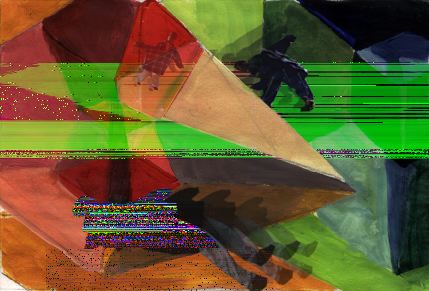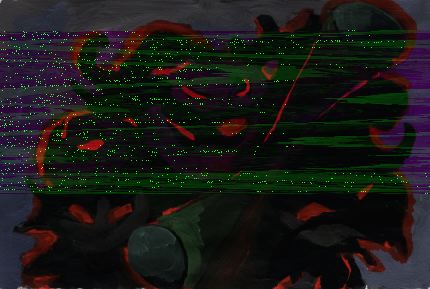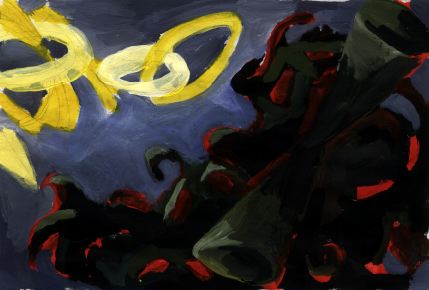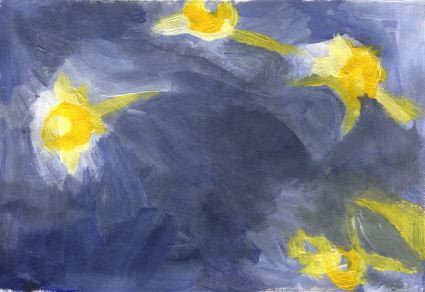
A Wrinkle in Time contains many ideas which are difficult to conceive visually. Many passages, especially those in which characters travel in more than three dimensions, describe feelings and thoughts without reference to vision. The idea of creating a screenplay for this novel appeals to us precisely because of this challenge of translating linguistic and mathematical concepts to visual media. The challenge is complicated by the need to be true to the book's original format and integrity and mathematical accuracy, which must be balanced with our desire to create a visually exciting movie.
In our creation of a concept for the film, we decided to combine ordinary film (photography in the storyboards) with animation (paintings). In doing so, we hope to show the coexistence of abstract concepts and physical reality. The characters begin in a normal setting, and upon entering higher dimensions their environment becomes the new reality of painted backgrounds. The people themselves remain videotaped, showing that their fantastic adventures are not merely imaginary.
In the following storyboards, we have concentrated on two short, specific passages from the novel: 1) Meg, Calvin, and Charles Wallace are Tessering in higher dimensions. They soon find themselves thrust onto a two dimensional planet. This occurs in chapter 5, he Tesseract (p. 76). 2) At the beginning of chapter 6 (p. 86), the children visit the Happy Medium. She shows them a picture of the earth, covered by the Black Thing, in her crystal ball. As they watch, the earth recedes from view, and the picture moves out of the Milky Way. Then, they see The Darkness again, frightening and writhing. Light bursts through The Darkness, destroying it.
We chose these passages because they are important thematically and because they resist visualization. The tessering sequence, especially, is described in the book as "nothingness." Meg feels only "the dissolution of her body." The move to two dimensions is a feeling of "being completely flattened."
In making artistic decisions of how to convey these feelings, we relied on symbolic use of color and distorted perspectives. We envision the tessering sequence as happening quickly-shapes and colors spinning by, bodies flashing in and out among the shapes, never really existing in space as we know it. The children's three dimensional bodies, given new "degrees of freedom" in higher dimensions, behave much like geometric shapes do in multiple dimensions. This we showed by doubling and tripling their images, just as a cube is duplicated to create a hypercube, as well as distorting the images of the children. When the children then visit the two-dimensional world, they become only silhouettes, dangerously transformed in this world whose colors mirror those of The Black Thing.
In representing the Black Thing, we adopted L'Engle's mention of red eyes (for example, of the man in the Central Central Intelligence Building in Camazotz). Although in the book the Black Thing does not have human characteristics, we felt it necessary to enliven the plain black blob to emphasize its terrifying power. The yellow light that invades the darkness is composed exclusively of mathematical figures: linked rings and a hypersphere. As L'Engle described, "The light spread out and where it touched the Darkness the Darkness disappeared." The mathematical, therefore, is associated with the side of good against evil.




"There was a gust of wind and a great thrust and a sharp shattering as she was shoved through-what?. . . If Calvin was still holding her hand she could not feel it. But this time she was prepared for the sudden and complete dissolution of her body," (p. 76).

"Without warning, coming as complete and unexpected shock, she felt a pressure she had never imagined, as though she were being completely flattened out by an enormous steam roller. This was far worse than the nothingness had been; while she was nothing there was no need to breathe, but now her lungs were squeezed together so that although she was dying for want of air there was no way for her lungs to expand and contract, to take in the air that she must have to stay alive. . . She tried to gasp, but a paper doll can't grasp. She thought she was trying to think, but her flattened-out mind was as unable to function as her lungs; her thoughts were squashed along with the rest of her. Her heart tried to beat; it gave a knivelike, sidewise movement, but it could not expand.
"But then she seemed to hear a voice, or if not a voice, at least words, words flattened out like printed words on paper, "Oh, no! We can't stop here! This is a two-dimensional planet and the children can't manage here!" (pp. 76-77).

" 'Llookk!' Mrs. Which commanded. . .
"For a moment there was the darkness of space; then another planet. The outlines of this planet were not clean and clear. It seemed to be covered with a smoky haze. Through the haze Meg thought she could make out the familiar outlines of continents like pictures in her Social Studies books," (pp. 82-83).

"Again they focused their eyes on the crystal ball. The earth with its fearful covering of dark shadow swam out of view and they moved rapidly through the Milky Way. And there was the Thing again.
" 'Watch!' the Medium told them," (p. 86).


"The Darkness seemed to seethe and writhe. Was this meant to comfort them?" (p. 86).

"Suddenly there was a great burst of light through the Darkness," (p. 86).

"The light spread out and where it touched the Darkness the Darknes disappeared," (p. 86)

"The light spread until the patch of Dark Thing had vanished, and there was only a gentle shining, and through the shining came the stars and starlight. No shadows. No fear. Only the stars and the clear darkness of space, quite different from the fearful darkness of the Thing," (p. 86).
paintings by Abigail Ranger
photographs and computer graphics by Karen Siegel


© 1998 by Eli Weiss. Last modified: Sunday Dec 13, 1998















